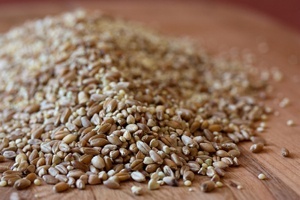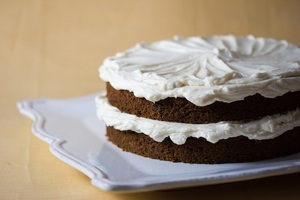Grain and Legume Cooking Time Chart
 I always used to get so impatient when cooking grains or legumes. Instead of really looking into it, I'd just dump about equal parts millet and water into a pot, crank up the heat and come back to it later to deal with it. It never seemed to work out. It turns out that all grains and legumes really want are a little bit of attention. If you take that extra second to give them the water and heat they need, they'll sing to you and come out perfect every time, regardless of how much you're making. The time it takes to refer to the below chart will more than make up for itself compared to guessing and wasting time trying to fix the situation later. So keep it handy! I actually have a printed out copy taped to the inside of one of my cupboard door so I have no excuse.
I always used to get so impatient when cooking grains or legumes. Instead of really looking into it, I'd just dump about equal parts millet and water into a pot, crank up the heat and come back to it later to deal with it. It never seemed to work out. It turns out that all grains and legumes really want are a little bit of attention. If you take that extra second to give them the water and heat they need, they'll sing to you and come out perfect every time, regardless of how much you're making. The time it takes to refer to the below chart will more than make up for itself compared to guessing and wasting time trying to fix the situation later. So keep it handy! I actually have a printed out copy taped to the inside of one of my cupboard door so I have no excuse.Cooking grains and legumes simply involves exposing them to a certain amount of water and heat until they have absorbed a specific amount of water. When grains and legumes are exposed to this water and heat, their starch granules and proteins swell as they hydrate and they get softer as a result. If the starch granules absorb too much water, they can rupture and some of the starch will leak outside the grain or legume and start to thicken the water. This starch rupturing is desired in certain starch-thickened sauces utilizing such thickeners as corn starch, potato starch or tapioca starch. It's undesirable in cooked grains and legumes because they are usually preferred whole and intact.
Grains should always be rinsed before cooking. Rinsing removes any dust as well as surface starches that can contribute harsh bitter flavors. This is especially true with quinoa.
It's important to always soak legumes for 8 to 24 hours in water then drain because they contain complex sugars called oligosaccharides. These eight glucose molecule chains are unable to be broken down in the small intestine like most other foods and are instead passed into the colon where they're digested by bacteria which create intestinal gas as a byproduct. Soaking the legumes in water allows enzymes in the beans to break down the oligosaccharides into smaller sugars so they can be digested in the small intestine, resulting in less intestinal gas. Boiling legumes does not break these oligosaccharides down. Soaking will also allow them to cook faster and use less energy from your burner. Feel free to soak legumes and freeze them for later use. Just don't pre-boil them before soaking because this will deactivate the enzymes that break down the oligosaccharides, leaving them intact.
The chart below details how much water and how much time 1 cup of grains or legumes would need to cook completely at simmering temperature (about 200F or 93C) in a saucepan that's covered or semi-covered. Please note that all measurements are approximate. Happy simmering!
Cooking Times for Grains and Beans
| 1 Cup Grain or Legume | Water Needed | Cooking Time | Cups Yeilded |
|---|---|---|---|
| Adzuki Beans | 4 cups (945 mL) | 50 minutes | 3 cups (710 mL) |
| Anasazi Beans | 2 ¾ cups (650 mL) | 50 minutes | 2 ¼ cups (530 mL) |
| Amaranth | 2 cups (475 mL) | 30 minutes | 2 ½ cups (590 mL) |
| Barley, whole | 3 cups (710 mL) | 50 minutes | 3 ½ cups (830 mL) |
| Barley, pearled | 2 ½ cups (590 mL) | 40 minutes | 3 ½ cups (830 mL) |
| Black Beans | 4 cups (945 mL) | 1 hour, 15 minutes | 2 ¼ cups (530 mL) |
| Black-eyed Peas | 3 cups (710 mL) | 1 hour | 2 cups (475 mL) |
| Buckwheat | 2 cups (475 mL) | 15 minutes | 3 ½ cups (830 mL) |
| Cannellini Beans | 3 cups (710 mL) | 45 minutes | 2 ½ cups (590 mL) |
| Chickpeas (Garbanzo Beans) | 4 cups (945 mL) | 1 hour, 15 minutes | 2 cups (475 mL) |
| Fava Beans | 3 cups (710 mL) | 50 minutes | 1 ¾ cups (415 mL) |
| Kamut | 3 cups (710 mL) | 40 minutes | 2 ½ cups (590 mL) |
| Kidney Beans | 3 cups (710 mL) | 1 hour | 2 ¼ cups (530 mL) |
| Lima Beans | 4 cups (945 mL) | 1 hour | 2 ½ cups (590 mL) |
| Millet | 3 cups (710 mL) | 30 minutes | 3 ½ cups (830 mL) |
| Mung Beans | 2 ½ cups (590 mL) | 1 hour | 2 cups (475 mL) |
| Navy Bean | 3 cups (710 mL) | 50 minutes | 2 ¾ cups (650 mL) |
| Oats, whole | 3 cups (710 mL) | 1 hour | 3 ½ cups (830 mL) |
| Oats, rolled | 2 ½ cups (590 mL) | 15 minutes | 3 ½ cups (830 mL) |
| Orzo | 2 cups (475 mL) | 20 minutes | 3 cups (710 mL) |
| Peas, green | 6 cups (1.4 L) | 1 hour, 30 minutes | 2 cups (475 mL) |
| Pinto beans | 3 cups (710 mL) | 1 hour, 15 minutes | 2 ¾ cups (650 mL) |
| Quinoa | 2 cups (475 mL) | 20 minutes | 2 ¾ cups (650 mL) |
| Rice: Short Brown | 2 cups (475 mL) | 55 minutes | 3 cups (710 mL) |
| Rice: Long Brown | 1 ½ cups (355 mL) | 45 minutes | 3 cups (710 mL) |
| Rice: Brown Basmati | 1 ½ cups (355 mL) | 45 minutes | 3 cups (710 mL) |
| Rice: Short White | 1 ½ cups (355 mL) | 15 minutes | 3 cups (710 mL) |
| Rice: Long White | 2 cups (475 mL) | 15 minutes | 3 cups (710 mL) |
| Rice: White Basmati | 1 ¾ cups (415 mL) | 35 minutes | 3 cups (710 mL) |
| Rice: Wild | 2 ½ cups (590 mL) | 50 minutes | 4 cups (945 mL) |
| Rye, whole | 2 ½ cups (590 mL) | 1 hour | 3 cups (710 mL) |
| Rye, flaked | 3 cups (710 mL) | 30 minutes | 3 cups (710 mL) |
| Spelt | 3 cups (710 mL) | 25 minutes | 2 ½ cups (590 mL) |
| Teff | 4 cups (945 mL) | 20 minutes | 3 ½ cups (830 mL) |
| Wheat | 3 cups (710 mL) | 1 hour | 2 ½ cups (590 mL) |
| Soy beans | 4 cups (945 mL) | 3 hours, 30 minutes | 3 cups (710 mL) |




